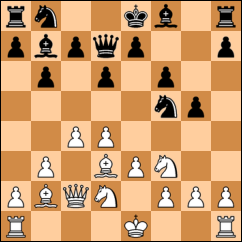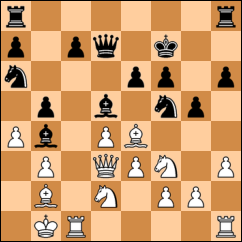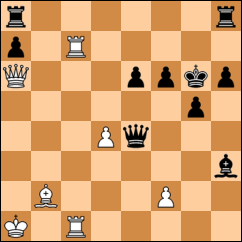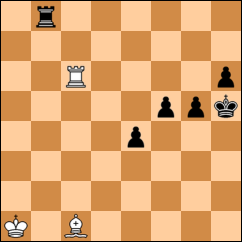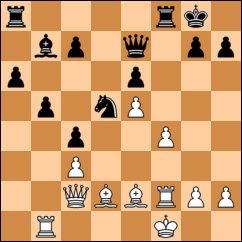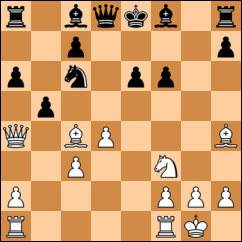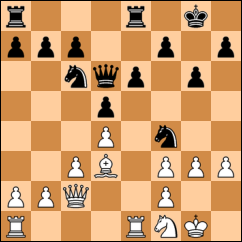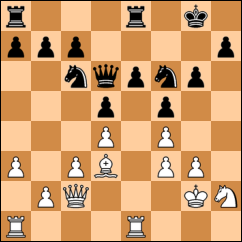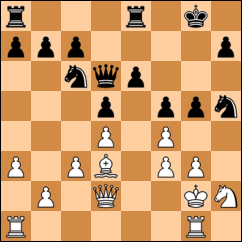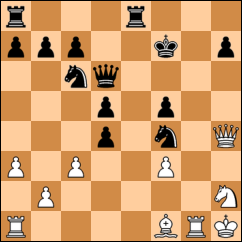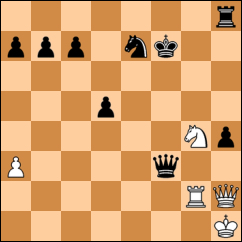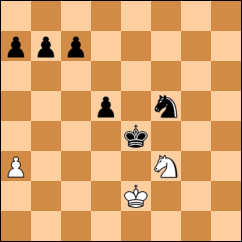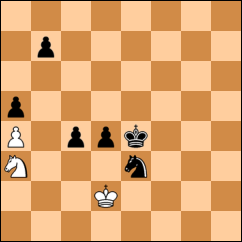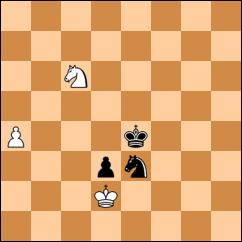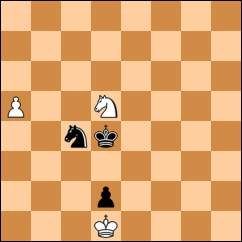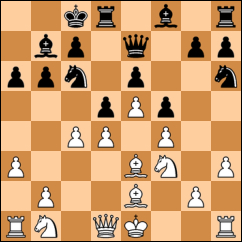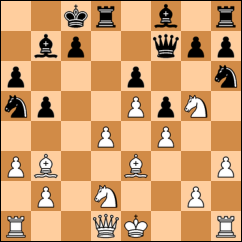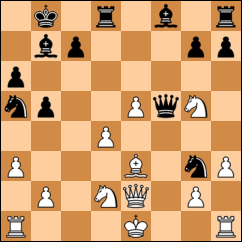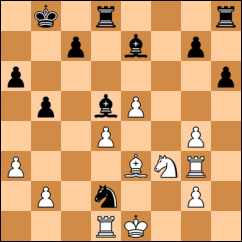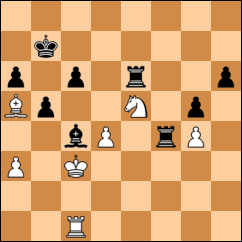This week, Steve McWhirter defended his spot at the top of the ladder against two challengers, Bill Koester and Jim Strong. Bill went first. Here's a problem from that game:
S.McWhirter–W.Koester
Route 20 Chess Club
Freeport, Illinois, Nov. 10, 2009
Bill has just played 13...b5. White to move. (Highlight to reveal answer.)
14.Bxb5! The pawn fork threat, which seems nasty at first glance, is toothless -- white can recapture without fear, since black's defending pawn is pinned. 14...axb5 15.Qxa8 contains the damage, but Bill's response, 14...Bb7 (trying to keep from losing the rook), makes matters worse: 15.Bxc6+ Bxc6 16.Qxg6+. Bill resigned four moves later.
And now for our feature presentation:
J.Strong–S.McWhirter
Route 20 Chess Club
Freeport, Illinois, Nov. 10, 2009
1.d4 d5 2.Bf4 Nc6 3.Nf3 Bg4 4.c3 Bxf3 5.exf3 Nf6 6.h3
Was Jim trying to forestall ...Ng4? I can see how he might want to untangle his kingside pawns, but he has great queenside development opportunities (Bd3 or Bb5, Qb3 or Qa4, Na3, not to mention 0-0 to get the king off that e-file), making the h-pawn advance seem beside the point.
6...e6 7.Bd3 Bd6 8.Bxd6 Qxd6
The trade favors black. Jim should have dodged with 8.Bg5.
9.0-0 0-0 10.Nd2 Rfe8 11.Re1 Nh5
Erases black's edge. 11...e5!? would have been a strong advance, threatening to evict white from the center entirely.
12.Qc2 g6 13.Nf1 Nf4
Steve is still missing the power of ...e5.
14.g3
14...Nxh3+ Steve could have kept his edge by trading his knight for Jim's only developed minor piece with 14...Nxd3!?. Instead he took the loose pawn -- maybe because he got a check out of it? But the knight isn't well-placed on the h-file.
15.Kg2 Ng5 16.Nh2 f5
16...e5 is still Steve's best bet. What's holding him back?
17.f4 Ne4 18.f3
Scram! But Jim could have his own knight outpost with 18.Nf3!?. Now the position is equal again.
18...Nf6 19.a3
19...Nh5
Steve begins to pile pressure on f4, but Jim's f4-pawn isn't particularly weak -- and seeing as how it's guarded by another pawn, why is Steve going after it with pieces? Or is his eye on g3? That pawn is weaker, but Steve's knight isn't going to take it out alone. If it was going to be a pawn war, 19...h5 would have been strong, or the counterintuitive 19...Nb8, followed by 20...Nbd7 and clearing the way for his c-pawn to charge.
20.Qd2
Evidently, Jim is concerned enough for the f4-pawn's safety that he gives it more protection.
20...g5
Now things get interesting. If 21.fxg5, then 22.Qxg3+. Not an especially deadly attack, but enough to cause white some headaches. White has a plethora of suboptimal responses to 20...g5; his one opportunity to be slick is 21.Rh1, which allows him to charge forward with his knight: 22.Ng4 discovers an attack on black's hanging knight, making time for the forking attack 23.Nf6+. But even after that, black still has an edge.
21.Rg1
Personally, I can't see the point of this move at all -- but according to Fritz, it's actually white's third-best option, after 21.Rh1 and 21.Bb5 (the move I was eying at the time).
21...gxf4 22.gxf4?
The recapture seems natural enough, but it's actually a serious misjudgment. Black has two pieces defending his new acquisition; white, aside from his counterattacking pawn, has only his queen. Jim has just lost this square.
22...Nxf4+
With a two-pawn material edge, Steve might have been better off with 22.Qxf4!?, daring Jim to trade queens. (Jim would have been better off not taking the dare.)
23.Kh1+
Nice parry!
23...Kf7 24.Bf1
Is the purpose of this move to suppress the f4-knight? I don't see what else it can hope to accomplish on the kingside with black's pawns corking one diagonal and his own f-pawn corking the other. Why not put it on the queenside, where it can enjoy some activity?
24...e5
Better late than never. With a two-pawn lead, though, 24...Rg8 looks even better. 25...Rxg1+ is forcing (26.Kxg1 Rg8+ 27.Kh1 and black owns the file).
25.Qf2 exd4 26.Qh4
Eying that forlorn h-pawn.
26...h5
Steve spent a lot of time on this move, squirming in his seat. It's not terrible, but it leaves a hole for white's queen on g5 (a hole that wouldn't be there if Steve had played ...Rg8 earlier). A stronger retort is 26...h6!, a quiet move that subtly but firmly shuts out white's queen.
27.Qg5 Rg8 28.Qxf5+ Qf6 29.Qd7+??
Jim has a choice of checks, the best of which is the queen-rook combination 29.Qh7+ Rg7 30.Rxg7+ Qxg7 31.Qf5+ Qf6 32.Qh7+ Kf8 (black has a winning advantage and doesn't want to draw) 33.Qxc7. In contrast, 29.Qd7+, in the best-case scenario, loses an exchange: the most white can hope for is to trade his remaining rook for black's defending knight.
29...Ne7 30.Rxg8 Rxg8 31.Bh3
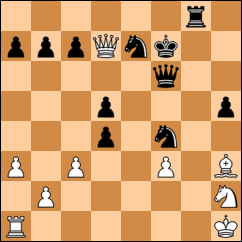
31.Re1 initiates the aforementioned exchange: 31...Qg5 32.Rxe7+ Qxe7 33.Qxe7+ Kxe7. Now white is in hot water, as black has several deadly retorts, the severest of which is the devastating 31...Qh4!!, which suppresses Re1 and threatens the dismantlement of white's kingside.
31...Nxh3
Awwww. This was a decidedly non-deadly retort. Steve still has a winning advantage, but Jim is no longer standing on the big, black X.
32.Qxh3 dxc3 33.bxc3 h4
33...Qg6 would defend black's hanging pawn and nail white's rook down to defense of the back rank.
34.Ng4
A thank-you move, forcing Steve to capture the pawn he wants to capture anyway. Jim was probably hoping to follow up with the fork Nh6+, but because he has to move his rook out of the way of Steve's queen, he doesn't have time.
34...Qxc3 35.Rg1 Rh8
Dodging the fork. But 35...Nf5 would have covered the forking square and put white in zugzwang. However, at this point, Steve has a three-pawn advantage; to win, all he needs to do is charge the promotion line. How can Jim stop him? He has to either take out a loose pawn (if Steve advances his knight, the c5-pawn will hang) or get his heavy pieces together on the same file for a counterthrust. At the same time, he doesn't want his own f-pawn to hang. 36.Qg2 would address all these issues.
36.Qh2
Uh-oh . . .
36...Qf3+
Nom nom nom.
37.Rg2
Jim had only two choices, neither of them good, but one (37.Qg2 Qxg2+ 38.Kxg2 Ke6) less bad than the other.
Massive simplification is in Steve's interest. He can set it up with 37...Rh5!! 38.Qe5 Qxg4 39.Rxg4 (39.Qxe7+ Kxe7 40. Rxg4) Rxe5 40.Rxh4, then begin his charge with 40...c5. But the power of this move is hard to see, and Steve didn't see it. He also didn't see a nasty, game-rescuing tactic that Jim had up his sleeve, which 37...Rh5 would have defended against as well.
37...h3 38.Ne5+! Ke6 39.Nxf3 hxg2+ 40.Kxg2 Rxh2+ 41.Nxh2 Nf5 42.Kf3 Ke5 43.Ke2 Ke4 44.Nf3?
Dangerous! 44...Nd4+ 45.Nxd4 Kxd4 is game-winning for black.
44...d4 45.Nd2+ Kd5 46.Kd3 c5
Finally, the charge begins!
47.a4 a5 48.Nb1?!
A weak move, played in zugzwang. 48.Nc4 would at least have returned the favor.
48...Ne3
48...c4+!? 49.Kc2 Ne3+ 50.Kd2 would have backed white up against the wall.
49.Na3 c4+ 50.Kd2
Same moves, different order for black -- but Jim has used his extra tempo to put his knight in an inferior location. Now 50...c3+! is game-ending for black.
50...Ke4
The game will not end yet.
Jim has only one rescuing move . . . and he finds it!
51.Nb5
Steve has a choice of several strong moves . . .
51...Nd5??
Oh, no! He overlooks the threat in Jim's next move.
52.Nd6+! Ke5?
Steve could have held a slight advantage with 52...Kf4 53.Nxc4 Ne3 54.Nd6 -- he'd have lost his b-pawn, but his a-pawn could have sprinted to the promotion line. White's king can't cover a1 and d1 at the same time, and his knight is too far away. But with Steve's king on e5, Jim not only picks up the c-pawn, he also gets a check and an extra tempo, with which he can take out the a-pawn as well if he wishes.
"I'm terrible at endgame," Steve admits. (Having lost other endgames to Steve, I wish I could agree!)
53.Nxc4+ Ke4 54.Nd6+ Ke5
Threatening a draw by repetition. But Jim doesn't like draws. He thinks he's got a shot at winning now, and he's going for it.
55.Nxb7 Ke4 56.Nxa5 d3
Watch out, Jim!
57.Nc6 Ne3
58.a5??
Uh-oh . . .
58...Nc4+
This is an interesting move, dangerous for reasons that aren't immediately obvious. The fork isn't the threat, because 59.Kc3 Nxa5 60.Nxa5 d2 61.Kc2 d1Q+ 62.Kxd1 is a draw. The real threat is in forcing white's king off the d-file so that black's pawn can promote. Jim obviously realizes this and tries to stay in the pawn's way, but it gets him in even worse trouble.
59.Kd1 Ke3 60.Nb4
At this point, Steve and Jim couldn't hold in the table talk any longer. Steve openly doubted that he had a way of forcing his pawn home. Jim didn't disagree. But Steve has 60...Nb2+!, which both guards the pawn and forces Jim's king off the queening square. With 61.Kc1 d2+ 62.Kxb2 d1Q, Jim's outlook would be bleak indeed. But as my NLP-obsessed dad says, "What the thinker thinks, the prover proves."
60...d2 61.Nc2+
It's looking awfully drawish now.
61...Kd3 62.Nb4+ Kc3 63.Nd5+ Kd4
64.Kc2??
A blunder that loses everything.
64...Kxd5 65.a6 Kc6
"Ohhhh, that's frustrating," Jim said. "What a bummer."
"Well," said Steve, "look at it from my point of view . . . "
66.a7 Kb7 67.a8Q+ Kxa8 68.Kd1 Ka7 69.Kc2 Kb6 70.Kd1 Kc5 71.Kc2 Kd4 72.Kd1 Kc3 73.Ke2 0-1

